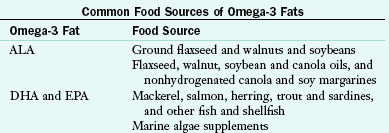Nutritional Facts on Essential (Omega) Fatty Acids
Essential fatty acids (EFAs) are fatty acids that are required in the human diet. They must be obtained from food because human cells have no biochemical pathways capable of producing them internally. There are two closely related families of EFAs: omega-3 (Ω-3 or ω-3) and omega-6 (Ω-6 or ω-6). Only one substance in each of these families is truly essential, because, for example, the body can convert one ω-3 to another ω-3 but cannot create an ω-3 from scratch.
In the body essential fatty acids serve multiple functions. In each of these the balance between dietary ω-3 and ω-6 strongly affects function. They are modified to make the eicosanoids (affecting inflammation and many other cellular functions); the endogenous cannabinoids (affecting mood, behavior, and inflammation); the lipoxins from ω-6 EFAs and resolvins from ω-3 (in the presence of aspirin, down-regulating inflammation); the isofurans, isoprostanes, hepoxilins, epoxyeicosatrienoic acids, and neuroprotectin D; and the lipid rafts (affecting cellular signaling). They also act on deoxyribonucleic acid (activating or inhibiting transcription factors for nuclear factor–κ-B [NFκB], a proinflammatory cytokine).
Between 1930 and 1950 arachidonic and linolenic acids were termed essential because each was more or less able to meet the growth requirements of rats given fat-free diets. Further research has shown that human metabolism requires both fatty acids. To some extent any ω-3 and any ω-6 can relieve the worst symptoms of fatty acid deficiency. However, in many people the ability to convert the ω-3 α-linolenic acid (ALA) to the ω-3 eicosapentaenoic (EPA) and docosahexaenoic acid (DHA) is only 5% efficient. Therefore it is important to incorporate the EPA and DHA directly into the diet usually as fish or a fish oil supplement. Particular fatty acids such as DHA are needed at critical life stages (e.g., infancy and lactation) and in some disease states.
The essential fatty acids are:
These two fatty acids cannot be synthesized by humans because humans lack the desaturase enzymes required for their production. They form the starting point for the creation of longer and more desaturated fatty acids, which are also referred to as long-chain polyunsaturates:
ω-6 Fatty acids
ω-9 Fatty acids are not essential in humans, because humans possess all the enzymes required for their synthesis.
Dietary Sources
Some of the food sources of ω-3 and ω-6 fatty acids are fish and shellfish, flaxseed (linseed), soya oil, canola (rapeseed) oil, hemp oil, chia seeds, pumpkin seeds, sunflower seeds, leafy vegetables, and walnuts.
EFAs play a part in many metabolic processes, and there is evidence to suggest that low levels of EFAs or the wrong balance of types among the EFAs may be a factor in a number of illnesses.
Plant sources of ω-3s do not contain EPA and DHA. This is thought to be the reason that absorption of EFAs is much greater from animal rather than plant sources.
EFA content of vegetable sources varies with cultivation conditions. Animal sources vary widely, both with the animal’s feed and that the EFA makeup varies markedly with fats from different body parts.
Omega-3 Fatty Acids
There is some evidence that suggests that ω-3s may:
• Help lower elevated triglyceride levels. High triglyceride levels can contribute to coronary heart disease.
• Reduce the blood’s tendency to clot, which may relate to the clogging that occurs with atherosclerosis.
• Reduce the inflammation involved in conditions such as rheumatoid arthritis.
• Improve symptoms of depression and other mental health disorders in some individuals.
Dietary sources of ω-3 fatty acids include fish oil and certain plant and nut oils. Fish oil contains both DHA and EPA, whereas some nuts (English walnuts) and vegetable oils (canola, soybean, flaxseed and linseed, olive) contain only the ω-3 ALA.
There is evidence from multiple large-scale population (epidemiologic) studies and randomized controlled trials that intake of recommended amounts of DHA and EPA in the form of fish or fish oil supplements lowers triglycerides; reduces the risk of death, heart attack, dangerous abnormal heart rhythms, and strokes in people with known cardiovascular disease; slows the buildup of atherosclerotic plaques (“hardening of the arteries”); and lowers blood pressure slightly. However, high doses may have harmful effects such as an increased risk of bleeding. Some species of fish carry a higher risk of environmental contamination such as with methyl mercury.

Enhancing Intake of Omega-3 Fats
• Eat fish at least two times each week.
• Include canned fish in your diet (examples: salmon, sardines, light tuna). Try sardines on toast.
• Add ground flaxseed to foods such as hot or cold cereal or yogurt. NOTE: Pregnant women should limit their intake of ground flaxseed to occasional use (not daily). Ground flaxseeds contain lignans. There is not enough information about their safety in pregnancy.
• Eat walnuts. Add walnuts to salads, cereals, baking (examples, muffins, cookies, breads) and pancakes.
• Have fresh or frozen soybeans (edamame) as a vegetable at meals.
• Use soybean oil or canola oil in salad dressings and recipes.
• Use nonhydrogenated margarine made from canola or soybean as a spread or in baking.
• Cook with ω-3 liquid eggs or eggs in the shell. Enjoy scrambled eggs or try a homemade egg sandwich.
• Use other ω-3 fortified products such as milk, yogurt, bread, and pasta.
• Substitute  cup ground flaxseed for
cup ground flaxseed for  cup flour in bread, pizza dough, muffin, cookie, or meatloaf recipes.
cup flour in bread, pizza dough, muffin, cookie, or meatloaf recipes.
• Replace 1 egg with 1 Tbsp ground flaxseed and 3 Tbsp water in recipes.
*Exact omega-3 content varies per manufacturer. Check label.
